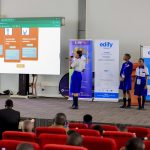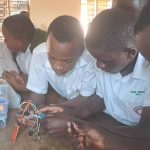The first session of the EdTech clubs course introduced participants to the core principles of project ideation, team formation, and how to effectively participate in the Edify EdTech Exhibition 2025. This session set the foundation for what students, teachers, and mentors would be engaging in throughout the course, ensuring all participants are aligned with the exhibition’s objectives.
Below is a detailed overview of the sub-units covered in the session, reflecting key insights from the meeting summary and the PowerPoint slides shared earlier.
1.1 Overview of EdTech Clubs & Tips for Sustainability
EdTech Clubs serve as an incubator for student-driven innovation, where technology is not just a tool for education, but a means to address real-world challenges. The meeting emphasized the importance of sustainability for EdTech clubs, encouraging school communities to integrate these clubs into the broader fabric of school life. Key sustainability tips included:
- Establishing clear leadership structures: Appointing leaders, such as a club president, project coordinators, and mentors, ensures consistency and accountability.
- Leveraging resources wisely: Clubs can source free or low-cost tools like open-source software, and engage local businesses or alumni for sponsorships and mentorship.
- Regular engagement: Weekly meetings or project sessions help maintain momentum and keep learners focused.
- Collaborative partnerships: Engaging other clubs or schools in joint activities can lead to cross-disciplinary projects that enrich learning.
The session inspired teachers and mentors to prioritize long-term growth for these clubs, setting up systems that can be maintained even after the exhibition Below is a Sample Constitution for Running an ICT Club.
1.2 Introduction to Edify Exhibition Theme
The Edify EdTech Exhibition 2025 centers around the theme of “Creating Impact through Technology and Christian Values”. Participants were encouraged to understand and internalize the core values of the theme: impact, technology, and Christian values.
- Impact: Projects must address real-world problems or bring tangible improvements to communities. This could be anything from an educational app, a robotics solution for environmental monitoring, to a video series promoting positive behavior.
- Technology Use: Projects should make meaningful use of technology, whether through multimedia, coding, or hardware solutions.
- Christian Values: The Edify exhibition stresses values such as compassion, integrity, service, and honesty. Technology should serve humanity, helping to foster a more just and caring society.
Teachers and mentors were reminded that Christian values must guide the creation of projects, ensuring that each project reflects these values in both purpose and execution.
1.3 Understanding Christian Values in Tech Projects
In this sub-unit, the integration of Christian values into technology projects was discussed in depth. Technology, when aligned with Christian principles, becomes a powerful tool for service, compassion, and ethical development.
Key Christian Values to Incorporate:
- Compassion: Developing solutions that make a meaningful difference in people’s lives, such as a health app or a robotics system that helps the disabled.
- Integrity: Projects should be transparent, with honest intentions and ethical practices.
- Service: Technology should be used to help others, reflecting the values of service over self-interest.
- Honesty: Projects must maintain honesty in their purpose and execution, ensuring they do not manipulate or mislead users.
The meeting emphasized that projects like educational videos, app development for community service, or robotics innovations can embed these values while addressing real challenges.
1.4 Defining Impactful Community Problems
An impactful project begins with identifying a real problem faced by the community. The meeting encouraged participants to focus on issues that are both relevant and feasible for technology-based solutions.
Characteristics of Impactful Problems:
- Relevance: Problems that are currently affecting communities or schools. Examples might include school bullying, environmental waste, lack of access to health information, or poor internet access for remote learning.
- Feasibility: Ensuring the problem can be realistically tackled with available technology. For example, developing a mobile app to help track water quality is more feasible than creating complex solutions for large infrastructure.
- Scalability: The problem should have the potential to impact a wider audience, not just a specific group or location.
By using technology to address these community problems, students are not just solving issues—they are creating innovative solutions that reflect the values of their community.
1.5 Brainstorming Project Ideas
The next step in the process is brainstorming project ideas. The meeting emphasized that ideas should come from real-world challenges and should be developed with a strong sense of purpose and social responsibility.
Tips for Brainstorming:
- Start with a broad problem: Focus on areas such as education, health, environment, or community development.
- Use technology creatively: Think about how apps, robotics, and multimedia tools can be used to address these challenges.
- Collaborate: Encourage teamwork and collaboration, which will bring different perspectives and ideas to the table.
- Align with the exhibition theme: Ensure your project addresses impact, uses technology, and reflects Christian values.
Brainstorming is about finding solutions that not only address issues but also inspire creativity, innovation, and collaboration among learners.
1.6 Project Team Formation & Roles
One of the critical factors for successful project execution is forming an effective team. The session detailed the roles within the team that help ensure every aspect of the project is covered.
Key Roles in a Project Team:
- Project Manager/Coordinator: Oversees the project’s progress, ensuring deadlines are met and tasks are completed on time.
- Coder/Developer: Responsible for programming, app development, and integrating technology into the project.
- Designer/Creative Lead: Focuses on visuals, multimedia creation, and presentation materials.
- Researcher: Gathers data and ensures the problem is well-understood and solutions are grounded in evidence.
- Presenter: Prepares the final pitch and delivers the presentation at the exhibition.
A balanced team will allow members to focus on their strengths while collaborating effectively to achieve a shared goal.
1.7 Preparing for the Touch Typing Challenges
The Touch Typing Challenge is an integral part of the Edify EdTech Exhibition 2025. Students will be tasked with improving their typing speed and accuracy, which is a critical skill for many aspects of digital work, including coding, content creation, and presentations.
Preparation Tips:
- Use Typing Master software: Encourage students to practice regularly to improve both speed and accuracy.
- Set daily practice goals: Aim for 10–15 minutes of typing practice each day.
- Focus on technique: Proper finger placement, posture, and hand positioning are crucial for improving typing speed.
- Measure progress: Track typing speed and accuracy to set personal goals and improve over time.
This challenge is not just about competition; it’s a skill that will serve students well in their academic and professional futures.
Conclusion
Session 1 of the EdTech course laid the foundation for successful project ideation, team formation, and alignment with the Edify EdTech Exhibition 2025 theme. Participants left with a clear understanding of how to ideate meaningful projects, integrate Christian values, and work collaboratively in teams. As the course progresses, these foundational steps will guide learners toward the successful development and presentation of their innovative tech projects.







Leave a Reply